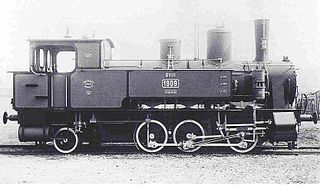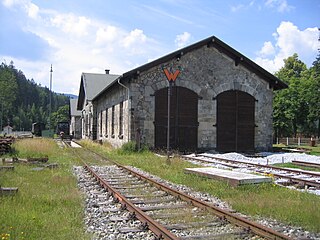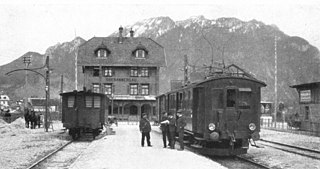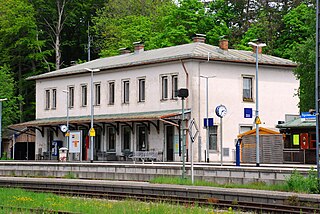The TAG 7 is a superheated steam locomotive, that was developed and built in 1936 by Krauss-Maffei as EAG 7 for the private Schaftlach-Gmund-Tegernsee Railway Company (Eisenbahn-Aktiengesellschaft Schaftlach-Gmund-Tegernsee or EAG) - later the Tegernsee Railway AG (TAG). Today it belongs to the Bavarian Localbahn Union.
This tank locomotive with its 1'D1' axle arrangement, together with its two sister engines LAG Nos. 87 and 88, is the last and most powerful branch line (Lokalbahn) locomotive to be built in Bavaria. Its power of 470 PSi enabled a top speed of 70 km/h in both directions. The EAG needed the new engines to relieve its two smaller locomotives, nos. EAG 5 and 6 (Bavarian GtL 4/4s) and to gradually take the aging and rickety EAG 3 and 4 out of service. TAG 7 proved itself so well, that a year later two more engines were built by the Lokalbahn AG (the aforementioned LAG Nos. 87 and 88).
TAG 7 served until 1975 as the reserve loco for the Tegernsee Railway (TAG), but at the same time, during the 1970s, was already being used for museum runs, organised by a working group of the German Railway History Company or DGEG. Because there was a threat that the engine would have to stop operating and be scrapped due to its licence running out, the Bavarian Localbahn Union was founded in order to raise the money for the required general inspection. The engine - de jure still the property of the TAG - remained stabled during the 1990s at Tegernsee, whilst the Localbahn Union paid for all further inspections and maintenance. In 1999, after the transfer of operations on the Tegernsee Railway to the Bavarian Highland Railway (Bayerische Oberlandbahn), the TAG finally sold the engine to the Union. At the same time the locomotive shed in Tegernsee had to be cleared. TAG 7 has been stationed in Landshut shed since and is once again in service. Since May 2005 TAG 7 has had PZB 90 train running control system. The locomotive is currently out of order due to a boiler damage, the owner BLV plans to build a new boiler.

The Class S 3/6 steam locomotives of the Royal Bavarian State Railways were express train locomotives with a 4-6-2 Pacific or 2'C1' wheel arrangement.

The Bavarian Class D XI engines were branch line (Lokalbahn) saturated steam locomotives built for service with the Royal Bavarian State Railways.
The Lokalbahn AG company, or 'LAG' for short, was a private company based in Munich, Bavaria, whose lines of business was the construction and operation of branch lines in Germany and Austria-Hungary. It existed from 1887 to 1938.

The Bavarian Class D VIII were saturated steam locomotives with the Royal Bavarian State Railways.
Locomotives 9 and 10 of the Lokalbahn AG (LAG) were saturated steam locomotives that were built for the Murnau - Garmisch-Partenkirchen route opened in 1889.

The Bavarian Class GtL 4/4 engines were superheated steam locomotives in service with the Royal Bavarian State Railways for duties on branch lines (Lokalbahnen).

Georg Krauß, from 1905 Ritter von Krauß was a German industrialist and the founder of the Krauss Locomotive Works in Munich, Germany and Linz, Upper Austria. The spelling of the company name was later changed from Krauß to Krauss, once the form of the name in capital letters on the company's emblems had become established.

The Bavarian Localbahn Society, with its headquarters in Tegernsee, is a society that is concerned with the history of the railways in Bavaria. Localbahn means 'branch line' and is mainly used in southern Germany and Austria in lieu of the usual term Nebenbahn. The BLV's objectives are the operation of historic trains and the collection of historically valuable railway items from Bavaria.

Bavarian branch lines comprised nearly half the total railway network in Bavaria, a state in the southeastern Germany that was a kingdom in the days of the German Empire. The construction era for branch lines lasted from 1872, when the first route, from Siegelsdorf to Langenzenn, was opened, to 1930, when the last section of the branch from Gößweinstein to Behringersmühle went operational.
The Bavarian engines with railway numbers 87 and 88 were superheated steam locomotives with the Localbahn AG (LAG). They were the last two engines that the LAG procured because shortly after their delivery in 1937, the company was finally nationalised. The locomotives were largely similar in their design to the TAG 7 locomotive, that had been developed in 1936 by Krauss-Maffei for the Tegernsee Railway AG. TAG 7 were the last branch line (Lokalbahn) locomotives to be designed and built in Bavaria. Unlike the two LAG engines, TAG 7 survived, first as the operating reserve for the Tegernseebahn and later as a museum locomotive. It is maintained by the Bavarian Localbahn Society and regularly used for museum trips around Munich.

The Regentalbahn is railway company based in Bavaria, and is owned by Ferrovie dello Stato and the Luxembourg infrastructure fund Cube, through the German holding company of Netinera. It runs railway infrastructure, as well as regional and long-distance passenger services in Bavaria and Saxony with links into the Czech Republic, and Germany-wide goods trains.

A Lokalbahn or Localbahn is a secondary railway line worked by local trains serving rural areas, typically in Austria and the south German states of Bavaria and Baden-Württemberg. Lokalbahnen appeared at the end of the 19th century before the use of cars became widespread.

Bayerisch Eisenstein/Železná Ruda-Alžbětín station is a railway station on the border of southeast Germany and the Czech Republic. It forms the junction between the Bavarian Forest railway from Plattling to Bayerisch Eisenstein, which was started in 1874 by the Bavarian Eastern Railway Company and completed by the Royal Bavarian State Railways, and the Pilsen–Markt Eisenstein railway built by the Pilsen–Priesen(–Komotau) railway in what was then Bohemia. The national border between Germany and the Czech Republic runs through the middle of the station building.

The Passauer Eisenbahnfreunde or PEF is a German railway society with the aim of preserving historic railway vehicles in working order in order to operate them.

The Landshut–Rottenburg railway was a German branch line in the southern state of Bavaria. It was a stub line, about 27.5 kilometres long, from Landshut to Rottenburg an der Laaber, and was known by the locals as the Rottenburger Bockerl. Although the line is now closed, there is a plan to establish a museum railway on the remaining section from Landshut to Unterneuhausen.

TAG Tegernsee Immobilien und Beteiligungs-AG is a property company from Germany with its head office in Hamburg. Until 1998 as Tegernsee-Bahn it operated the railway line from Schaftlach via Gmund to Tegernsee. The company is listed in the share index, MDAX.

The Ammergau Railway or Ammergaubahn is a single-tracked, electrified railway line in Bavaria in southern Germany. It runs from Murnau to Oberammergau, its latter stages following the valley of the river Ammer from which it derives its name. This stub line to Oberammergau branches off at Murnau from the Munich–Garmisch-Partenkirchen main line.

The Tegernsee station is the railroad station of the town of Tegernsee in the district of Miesbach, Upper Bavaria. It is the terminus of the railroad line coming from Schaftlach. Tegernsee station was built as part of the extension of the railroad line from Gmund station and was ceremonially opened on May 1, 1902.

The Schaftlach station is the railway station of Schaftlach and the only railway station in the municipality of Waakirchen in the district of Miesbach in Upper Bavaria. It is located on the Holzkirchen-Lenggries railway line, which opened in 1874, and has been a junction station since 1883, when the privately operated Schaftlach-Tegernsee railway went into service.
















